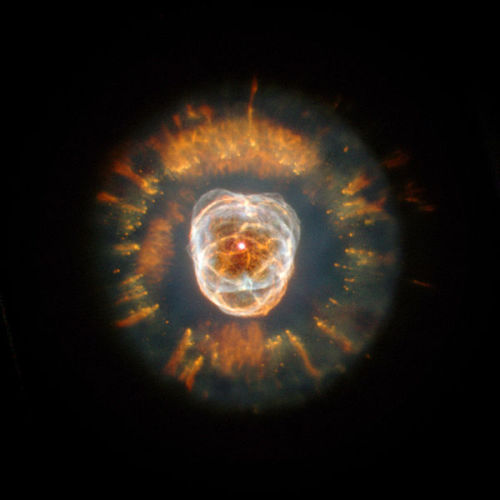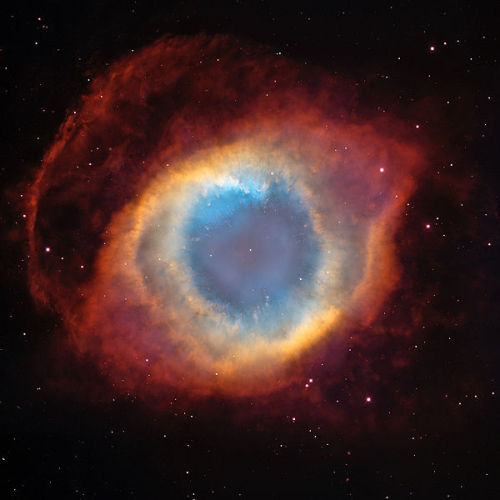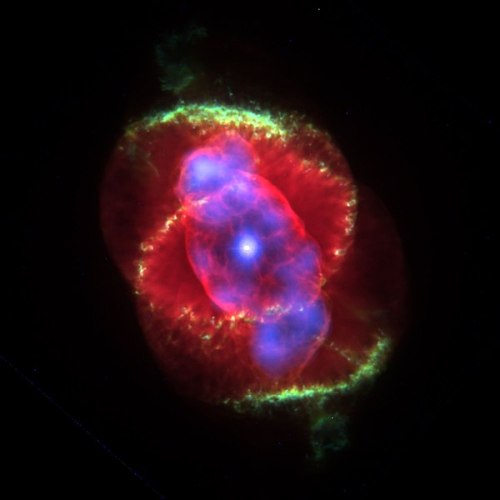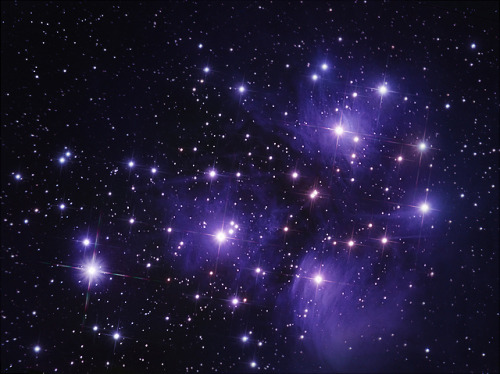🐾🐈💀
🐾🐈💀

More Posts from Monstrous-mind and Others
The diversity of worlds in our solar system (climate and geology)…

The Great Red Spot is a persistent high-pressure region in the atmosphere of Jupiter, producing an anticyclonic storm 22° south of the planet’s equator. It has been continuously observed for 188 years, since 1830. Earlier observations from 1665 to 1713 are believed to be of the same storm; if this is correct, it has existed for at least 350 years. Such storms are not uncommon within the turbulent atmospheres of gas giants.

With over 400 active volcanoes, Io is the most geologically active object in the Solar System. This extreme geologic activity is the result of tidal heating from friction generated within Io’s interior as it is pulled between Jupiter and the other Galilean satellites—Europa, Ganymede and Callisto.

Europa has the smoothest surface of any known solid object in the Solar System. The apparent youth and smoothness of the surface have led to the hypothesis that a water ocean exists beneath it, which could conceivably harbor extraterrestrial life.

Neptune, the eighth and farthest planet from the sun, has the strongest winds in the solar system. At high altitudes speeds can exceed 1,100 mph. That is 1.5 times faster than the speed of sound. In 1989, NASA’s Voyager 2 spacecraft made the first and only close-up observations of Neptune.

Ganymede is the largest and most massive moon of Jupiter and in the Solar System. Possessing a metallic core, it has the lowest moment of inertia factor of any solid body in the Solar System and is the only moon known to have a magnetic field. (Sounds of Ganymede’s magnetosphere).

Saturn’s hexagon is a persisting hexagonal cloud pattern around the north pole of Saturn, located at about 78°N. The sides of the hexagon are about 13,800 km (8,600 mi) long, which is more than the diameter of Earth (about 12,700 km (7,900 mi)).

Miranda’s surface has patchwork regions of broken terrain indicating intense geological activity in Miranda’s past, and is criss-crossed by huge canyons. It also has the largest known cliff in the Solar System, Verona Rupes, which has a height of over 5 km (3.1 mi).
Some of Miranda’s terrain is possibly less than 100 million years old based on crater counts, which suggests that Miranda may still be geologically active today.

Enceladus is the sixth-largest moon of Saturn. It is about 500 kilometers (310 mi) in diameter, about a tenth of that of Saturn’s largest moon, Titan. Evidence of liquid water on Enceladus began to accumulate in 2005, when scientists observed plumes containing water vapor spewing from its south polar surface, with jets moving 250 kg of water vapor every second at up to 2,189 km/h (1,360 mph) into space.

Titan is the largest moon of Saturn. It is the only moon known to have a dense atmosphere, and the only object in space, other than Earth, where clear evidence of stable bodies of surface liquid has been found.

Triton is one of the few moons in the Solar System known to be geologically active (the others being Jupiter’s Io and Europa, and Saturn’s Enceladus and Titan). As a consequence, its surface is relatively young with few obvious impact craters, and a complex geological history revealed in intricate cryovolcanic and tectonic terrains. Part of its surface has geysers erupting sublimated nitrogen gas, contributing to a tenuous nitrogen atmosphere less than 1/70,000 the pressure of Earth’s atmosphere at sea level.
source: wikipedia~
image credit: data and images from NASA








Planetary nebula
A planetary nebula, abbreviated as PN or plural PNe, is a kind of emission nebula consisting of an expanding, glowing shell of ionized gas ejected from red giant stars late in their lives. The word “nebula” is Latin for mist or cloud, and the term “planetary nebula” is a misnomer that originated in the 1780s with astronomer William Herschel because, when viewed through his telescope, these objects resemble the rounded shapes of planets. Herschel’s name for these objects was popularly adopted and has not been changed. They are a relatively short-lived phenomenon, lasting a few tens of thousands of years, compared to a typical stellar lifetime of several billion years.
Most planetary nebulae form at the end of the star’s life, during the red giant phase, when the outer layers of the star are expelled by strong stellar winds. After most of the red giant’s atmosphere is dissipated, the ultraviolet radiation of the hot luminous core, called a planetary nebula nucleus (PNN), ionizes the ejected material. Absorbed ultraviolet light energises the shell of nebulous gas around the central star, causing it to appear as a brightly coloured planetary nebula.
Planetary nebulae likely play a crucial role in the chemical evolution of the Milky Way by expelling elements to the interstellar medium from stars where those elements were created. Planetary nebulae are observed in more distant galaxies, yielding useful information about their chemical abundances.
Stars greater than 8 solar masses (M⊙) will likely end their lives in dramatic supernovae explosions, while planetary nebulae seemingly only occur at the end of the lives of intermediate and low mass stars between 0.8 M⊙ to 8.0 M⊙.
source
images: NASA/ESA, Hubble
🔭🌌🌃

Saturn - GREEN-BLUE-VIOLET - August 11 1981 Credit: NASA/JPL-Caltech/Kevin M. Gill

The Moon, Venus and Mercury at Dawn 1 - Feb 7, 2016
image credit: Joseph Brimacombe

Pleiades by Chuck Manges
🍂🍁🎃📚📓

🐈🌌🚀



Alien Directed by Ridley Scott (1979)
-
 samuli666 liked this · 3 years ago
samuli666 liked this · 3 years ago -
 storm-in-heaven reblogged this · 3 years ago
storm-in-heaven reblogged this · 3 years ago -
 celestial-querencia-quaintrelle reblogged this · 3 years ago
celestial-querencia-quaintrelle reblogged this · 3 years ago -
 celestial-querencia-quaintrelle liked this · 3 years ago
celestial-querencia-quaintrelle liked this · 3 years ago -
 sabastianamor liked this · 3 years ago
sabastianamor liked this · 3 years ago -
 loveex liked this · 3 years ago
loveex liked this · 3 years ago -
 myownnirvana liked this · 3 years ago
myownnirvana liked this · 3 years ago -
 bezkrai reblogged this · 4 years ago
bezkrai reblogged this · 4 years ago -
 bezkrai liked this · 4 years ago
bezkrai liked this · 4 years ago -
 thedrgnlvr liked this · 4 years ago
thedrgnlvr liked this · 4 years ago -
 ghostclout liked this · 4 years ago
ghostclout liked this · 4 years ago -
 late-nighthots liked this · 4 years ago
late-nighthots liked this · 4 years ago -
 strawberryblvsh liked this · 4 years ago
strawberryblvsh liked this · 4 years ago -
 trueconfessionsofacurvygirl reblogged this · 4 years ago
trueconfessionsofacurvygirl reblogged this · 4 years ago -
 artisticalmondsugar liked this · 4 years ago
artisticalmondsugar liked this · 4 years ago -
 gornwen liked this · 4 years ago
gornwen liked this · 4 years ago -
 frugalhoe reblogged this · 4 years ago
frugalhoe reblogged this · 4 years ago -
 frugalhoe liked this · 4 years ago
frugalhoe liked this · 4 years ago -
 majdoline reblogged this · 4 years ago
majdoline reblogged this · 4 years ago -
 blvcksvgvr reblogged this · 4 years ago
blvcksvgvr reblogged this · 4 years ago -
 why-must-i-be-like-this reblogged this · 4 years ago
why-must-i-be-like-this reblogged this · 4 years ago -
 why-must-i-be-like-this liked this · 4 years ago
why-must-i-be-like-this liked this · 4 years ago -
 n0eonheart liked this · 4 years ago
n0eonheart liked this · 4 years ago -
 gardengnomegang liked this · 4 years ago
gardengnomegang liked this · 4 years ago -
 rbtsam08 reblogged this · 4 years ago
rbtsam08 reblogged this · 4 years ago -
 mydemonexorcist liked this · 4 years ago
mydemonexorcist liked this · 4 years ago -
 mrstrials liked this · 4 years ago
mrstrials liked this · 4 years ago -
 impossibleartalternativething liked this · 4 years ago
impossibleartalternativething liked this · 4 years ago -
 thudd224 liked this · 4 years ago
thudd224 liked this · 4 years ago -
 dangerousalone liked this · 4 years ago
dangerousalone liked this · 4 years ago -
 roshytsunami reblogged this · 4 years ago
roshytsunami reblogged this · 4 years ago -
 mrnongtongpaw liked this · 4 years ago
mrnongtongpaw liked this · 4 years ago -
 nekonekotoast liked this · 4 years ago
nekonekotoast liked this · 4 years ago -
 lil-writing-demon liked this · 4 years ago
lil-writing-demon liked this · 4 years ago -
 r-u-a-kin liked this · 4 years ago
r-u-a-kin liked this · 4 years ago -
 otaldocsar liked this · 4 years ago
otaldocsar liked this · 4 years ago
My ambition is handicapped by laziness. -C. Bukowski Me gustan las personas desesperadas con mentes rotas y destinos rotos. Están llenos de sorpresas y explosiones. -C. Bukowski. I love cats. Born in the early 80's, raised in the 90's. I like Nature, Autumn, books, landscapes, cold days, cloudy Windy days, space, Science, Paleontology, Biology, Astronomy, History, Social Sciences, Drawing, spending the night watching at the stars, Rick & Morty. I'm a lazy ass.
222 posts
